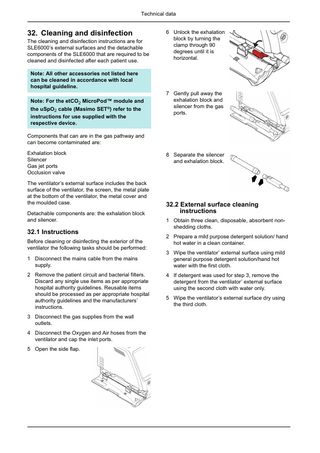Cleaning and Disinfection Instructions
2 Pages

Preview
Page 1
Technical data
32. Cleaning and disinfection The cleaning and disinfection instructions are for SLE6000’s external surfaces and the detachable components of the SLE6000 that are required to be cleaned and disinfected after each patient use.
6 Unlock the exhalation block by turning the clamp through 90 degrees until it is horizontal.
Note: All other accessories not listed here can be cleaned in accordance with local hospital guideline. Note: For the etCO2 MicroPod™ module and the uSpO2 cable (Masimo SET®) refer to the instructions for use supplied with the respective device.
7 Gently pull away the exhalation block and silencer from the gas ports.
Components that can are in the gas pathway and can become contaminated are:
Detachable components are: the exhalation block and silencer.
32.1 Instructions Before cleaning or disinfecting the exterior of the ventilator the following tasks should be performed: 1 Disconnect the mains cable from the mains supply. 2 Remove the patient circuit and bacterial filters. Discard any single use items as per appropriate hospital authority guidelines. Reusable items should be processed as per appropriate hospital authority guidelines and the manufacturers’ instructions. 3 Disconnect the gas supplies from the wall outlets. 4 Disconnect the Oxygen and Air hoses from the ventilator and cap the inlet ports. 5 Open the side flap.
The ventilator’s external surface includes the back surface of the ventilator, the screen, the metal plate at the bottom of the ventilator, the metal cover and the moulded case.
8 Separate the silencer and exhalation block.
Exhalation block Silencer Gas jet ports Occlusion valve
32.2 External surface cleaning instructions 1 Obtain three clean, disposable, absorbent nonshedding cloths. 2 Prepare a mild purpose detergent solution/ hand hot water in a clean container. 3 Wipe the ventilator’ external surface using mild general purpose detergent solution/hand hot water with the first cloth. 4 If detergent was used for step 3, remove the detergent from the ventilator’ external surface using the second cloth with water only. 5 Wipe the ventilator’s external surface dry using the third cloth.
Technical data
32.3 External surface disinfection instructions 1 Obtain two clean, disposable, absorbent nonshedding cloths. 2 Pour Alcohol (70% isopropanol) in a container. 3 Dampen one of the cloths in the Alcohol (70% isopropanol).
32.7 Gas jet ports disinfection 1 Obtain two clean, disposable, absorbent nonshedding cloths. 2 Pour Alcohol (70% isopropanol) in a container. 3 Dampen one of the cloths in the Alcohol (70% isopropanol).
4 Wipe the ventilator’s external surface with the alcohol-wetted cloth.
4 Wipe the two jet ports with the alcoholwetted cloth.
5 Wipe the ventilator’s external surface dry using the second cloth.
5 Wipe the dry using the second cloth.
OR 6 Wipe the ventilator’s external surface using Alcohol (70% isopropanol) wipes. 7 Allow to dry.
32.4 Exhalation block cleaning instructions Note: For use of automatic washers please follow hospital guidelines. 1 Prepare a mild purpose detergent solution/ hand hot water in a clean container. 2 Wash the exhalation block in the mild general purpose detergent solution / hand hot water. 3 Rinse with sterile water.
32.8 Occlusion valve If the occlusion valve which is internally mounted is deemed to have been contaminated it can only be cleaned by a service technician as it requires ventilator disassembly.
32.9 Cleaning of main air intake filter. 1 Remove the fan filter guard (1). No tool required.
4 Allow to dry.
2
5 Check that the pressure relief valve ball rattle when the exhalation block is shaken. If not rewash and ensure any residue is removed that may be sticking the balls in place.
1
32.5 Exhalation block disinfection instructions 1 Pour Alcohol (70% isopropanol) in a container, enough to submerge the exhalation block in it. 2 Immerse the exhalation block in Alcohol (70% isopropanol) for 30seconds. 3 Allow to dry for an hour. 4 Autoclave with pure dry saturated steam at 134°C at 320kPa with a minimum holding time of 3 minutes or 121°C at 210kPa with a minimum holding time of 15 minutes.
32.6 Silencer disinfection instructions 1 Autoclave with pure dry saturated steam at 134°C at 320kPa with a minimum holding time of 3 minutes or 121°C at 210kPa with a minimum holding time of 15 minutes. Note: The silencer can be autoclaved up to 25 times. Mark the silencer with an autoclavable marker after each autoclave cycle to indicate the number of autoclave cycles completed.
2 Remove the filter (2). 3 Wash the filter (2) in clean water. Warning. Do not wring or deform the filter as this will cause it to loose its shape. 4 Dry the filter (2) between paper towels until no moisture is left. 5 Replace the filter (2) and filter guard (1).